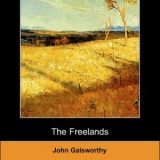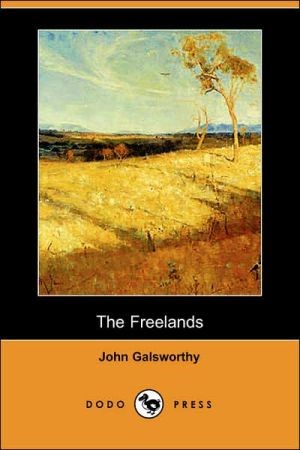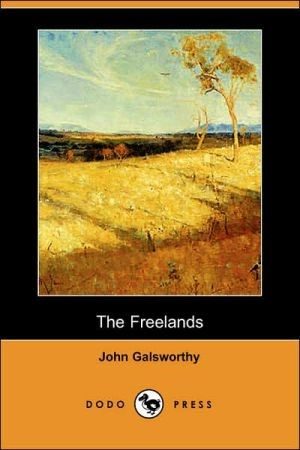The Freelands – John Galsworthy – 1914
Reviewed by: Jason Tomes Date: 12 March 2005
The Freelands is one of the lesser known works of its author. Devotees of Galsworthy will nevertheless discover in it many of his characteristic merits. The storytelling is thoughtful, humane, and unforced. The prose is wonderfully simple: lucid, expressive, evocative, and unpretentious. As a stylist, Galsworthy excelled in the art that conceals art.
 On the other hand, I would hesitate to recommend The Freelands as an introduction to this writer, unless the prospective reader has a pre-existing interest in the social and economic condition of England – specifically rural England – before the First World War, for this book is to a considerable degree a work of social criticism. (As such, it resembles Galsworthy’s contemporary ‘problem plays’, both generally and in certain particulars. e.g. anyone who has seen Justice is sure to recall its famous prison scene when reading the chapter about Bob Tryst on remand.) Moreover, it is now heavily dated social criticism, since the specific circumstance examined – the lot of the farm worker in the employ of the gentry – has virtually disappeared. Galsworthy repeatedly refers to ‘the Land Question’, assuming that readers will be familiar with the term. In Britain in 1912, no doubt they were; in 2005, they are probably not. The novel relates to the depressed condition of British agriculture between the 1870s and the Second World War, a period when an influx of imported food (principally from the USA) overwhelmed domestic farming and made people ask if it had any future. Galsworthy, unusually, signalled his socio-political intent by dedicating The Freelands to John and Barbara Hammond, left-leaning historians, whose noted study of The Village Labourer had appeared in 1911.
On the other hand, I would hesitate to recommend The Freelands as an introduction to this writer, unless the prospective reader has a pre-existing interest in the social and economic condition of England – specifically rural England – before the First World War, for this book is to a considerable degree a work of social criticism. (As such, it resembles Galsworthy’s contemporary ‘problem plays’, both generally and in certain particulars. e.g. anyone who has seen Justice is sure to recall its famous prison scene when reading the chapter about Bob Tryst on remand.) Moreover, it is now heavily dated social criticism, since the specific circumstance examined – the lot of the farm worker in the employ of the gentry – has virtually disappeared. Galsworthy repeatedly refers to ‘the Land Question’, assuming that readers will be familiar with the term. In Britain in 1912, no doubt they were; in 2005, they are probably not. The novel relates to the depressed condition of British agriculture between the 1870s and the Second World War, a period when an influx of imported food (principally from the USA) overwhelmed domestic farming and made people ask if it had any future. Galsworthy, unusually, signalled his socio-political intent by dedicating The Freelands to John and Barbara Hammond, left-leaning historians, whose noted study of The Village Labourer had appeared in 1911.
Freeland is the surname of the central family in the story. At the same time, the title must be a sardonic comment on the fate of those who worked on the land and found themselves far from free. Less than a hundred years on, the extent to which Edwardian country landowners felt that they had the right – indeed a duty – to interfere in the private lives of their tenants and employees strikes a modern reader as astonishing.
Galsworthy is rarely at his best when writing about characters outside his own (upper-middle) class. Here the landowning upper class is represented by Sir Gerald and Lady Malloring: satirical stereotypes, acceptable as such. The problem lies in the patronising portrayal of the working-class characters. Readers may well cringe at the unconvincing (if well-meant) treatment of Wilmet Gaunt, the roguish village wench, and Bob Tryst, the downtrodden farm-worker. Galsworthy does not even seem altogether at ease when writing about the more eccentric members of his own class: Tod Freeland is a typically uncommunicative ‘gentle giant’; his wife Kirsteen is a fiery Celt, prone to passionate rhetoric. Far more successfully Galsworthian are the rest of the Freelands. Felix, the liberal literary man, bows to social and moral convention while painfully aware of its shortcomings. He is not very far removed from Young Jolyon in The Forsyte Saga (or from the author himself). Stanley Freeland is the happily unreflective man of business. Their mother is a sweet-natured, practical, uncomprehending old lady, rather like Mrs Pendyce in The Country House, advanced in years. Nedda and Derek are young lovers – and Galsworthy always wrote beautifully about young love.
More generally, indeed, the quality of the writing offsets the weakness of the some of the characterisation. There is much to enjoy in The Freelands – but it does help if you have some background knowledge of early twentieth-century British social history.
















